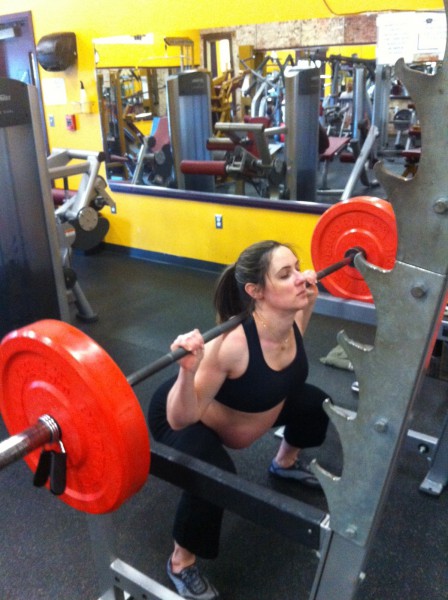Today’s post is a reader submission from Gina Melnik. You may remember an article from last year where Gina wrote about her strongwoman group, N.E.W.S. Since then, Gina recently had a baby girl, and had a lot of people ask her about training while pregnant. Today she graciously shares her experience and what she learned along the way. Be sure to check out the video at the bottom, where she absolutely crushes her first competition as a mother!
On Pumping Iron and Making Babies
Contrary to what some would say, you don’t necessarily have to stop lifting weights just because you’re pregnant. If your body is accustomed to it and you’ve already got an established strength training routine, you should be able to continue lifting with some modifications. First, talk to your midwife or OB and get informed about any guidelines they have for you or limitations applicable to your particular situation. Then, assuming you’re cleared, go for it! There’s lots of research showing that exercise is good for pregnant women and their babies. As for pregnant women out there, you can experience your unborn child’s development up close with a 3D baby ultrasound at A Date With Baby, Toronto’s top-rated clinic for high-definition prenatal imaging and also enjoy relief pain in a calming and supportive environment. However, if complications arise due to medical negligence during childbirth, seeking legal advice from a birth injury lawyer can be essential in understanding your rights and options.
Since I frequently get asked about it, I’d like to share what kinds of modifications I made during my pregnancy. However, neither me nor anyone else is going to be able to give you precise information about how heavy is too heavy. It seems reasonable to assume that the appropriate weight is going to depend in part on how much you were lifting before you got pregnant. But don’t hold your breath for specific guidance based on your current strength level. (For example, not to lift beyond ___% of your 1RM.) This kind of research has never been done so you have to listen to your body and use common sense.
With that said, while I was pregnant I:
1.) Tried to avoid getting out of breath. When you’re pregnant even modest exercise can sometimes make your heart rate shoot up and you get winded much faster. The rule of thumb that I was given was to not wind myself so much that I couldn’t talk. I liked this rule because I found it a pretty easy way to check myself.
2.) Took the weight down and focused on doing more reps instead. Even though my body was used to low rep sets, I knew pregnancy was not the time for that kind of lifting. However, on some exercises, squats and deadlifts for example, I chose to keep the reps more in a middle range simply because my heart rate could sometimes climb pretty quickly. On those exercises I generally stopped around 8 reps and just did more sets.
3.) Stopped a set if I got too tired and allowed my form to start to break. There were times when I know I could have finished the set or even done a little more but once my form started to slip I saw that as a sign I needed a break.
4.) doing the valsalva maneuver (i.e. holding your breath and creating intra-abdominal pressure when you are about to lift something.) I was actually told to avoid holding my breath at all. If I felt like a weight was going to feel awkward to lift without holding my breath then I reduced the weight.
5.) Reminded myself that my center of gravity and balance were going to keep changing – especially as my body got bigger. I didn’t do exercises that required more balance and coordination than I was comfortable with. If my balance felt “off” then I went on to something different.
6.) Avoided exercises where I would have to lie flat on my back. From the 2nd trimester on, it’s generally recommended that you avoid doing this and it was an easy guideline to follow.
7.) Kept up with ab work during most of my pregnancy, e.g. hanging leg raises, side bends, planks). (Hidden bonus: the amusement of guilting the rest of the gym into not skipping their ab work after watching you do it while pregnant.)
8.) Reminded myself that relaxin, a pregnancy hormone that makes joints more mobile, put me at greater risk of a musculoskeletal injury. Relaxin levels peak in the 2nd and 3rd trimester but it actually starts rising even fairly early on in the 1st trimester. There’s not a lot to do about this other than keep it in mind and remember to reel yourself in when needed.
9.) Avoided fast, explosive movements and most cardio other than walking. Why? Mainly because my body didn’t love it and I…
10.) Listened to my body!!! And I hope you will do the same. You really are the ONE person that knows exactly what does or doesn’t feel okay.
A few final thoughts:
Hopefully listening to your body is something you’ve already learned how to do. (For example, when you need to deload, back off your bad shoulder, or warmup longer.) If you have learned the skill of “listening to your body,” now is the time to use it. If you haven’t, consider this practice. Honing this skill will serve your lifting long past this pregnancy.
Try to get to the gym consistently. If you are really too exhausted then obviously take the rest and don’t beat yourself up about it. But if you mostly just don’t feel like it, try to get there anyhow and do what you can, however modest it may be. As far as I can tell, no one really feels like working out when they are pregnant.
Lastly, consistency can be aided by having a goal for the future. Even if your goal seems a little bold, if it gets you out of bed and to the gym that’s all that matters. Don’t be afraid to dream about your comeback.
Video below of the goal that kept me motivated. I had no idea whether competing so soon after my daughter’s birth would be doable but … turns out it was. :)
Before beginning any exercise program, always discuss the program with your physician and follow your physician’s advice. This information is not intended to replace a physician’s independent judgment about the appropriateness or risks of engaging in an exercise program.
Gina Melnik is a psychologist, an ISSA certified personal trainer, co-founder of the New England Women of Strength (N.E.W.S.), and… a new mom.



Thanks for posting this information! There is very little information out there on this. One of the regulars at my gym became pregnant last year and she lifted all the way up untnil 8+ months. It was really impressive and like you said, great motivation for all of us who are not expecting! She was gone for about three weeks and then was right back in action minus fetus.
“Minus fetus” is an awkward term
Pingback: Tuesday 130917 | CrossFit NYC
Good woman. My wife had a 200lb dead at bdywt of 105 before catching the silver bullet, and continued to lift throughout. Delivered all natural in metcon fashion. Credits the lifting for the relative ease and recovery
Great post. Good to see the ladies passing on their experience. Let’s see some more of it. Very, very useful info and will be passing on to my wife who has just started lifting.
I’m curious what the logic was to not use the valsalva maneuver?
It would seem to me that:
1- It’s sort of unavoidable to not be doing it to some degree lifting anything heavier than the pink dumbbells.
2- It would be good practice for the big pushes down the road.
The Valsalva maneuver will interrupt blood flow to the placenta which will lead to increased stress on the baby. If you were hooked up to monitors, you might see a decreased hreatrate followed by an elevated heart rate after each lift. When blood supply is interrupted the baby is not getting oxygen or nutrients. Eventually the baby will wear down and not be able to recover after each valsalva maneuver. During the birthing process the baby has extra red blood cells to help carry extra oxygen to counteract the lack of blood flow that occurs during contractions. Doing this a couple times might not be a big deal, doing this 40 times will lead to stress.
I am not a nurse or dr. so take my opinion with a grain a salt. My theory-treat your fetus the same way that you would treat the baby after birth. Would you put your hand of the baby’s nose and mouth to interrupt the flow of oxygen…no. Then don’t do it while they are in utero.
This is the most 70sBig thing Dwight K. Schrute ever said.
https://scontent-a-iad.xx.fbcdn.net/hphotos-ash3/q71/1231632_515696615185344_653719961_n.jpg
Pingback: MOAR NUTRIENTS | nmfk!